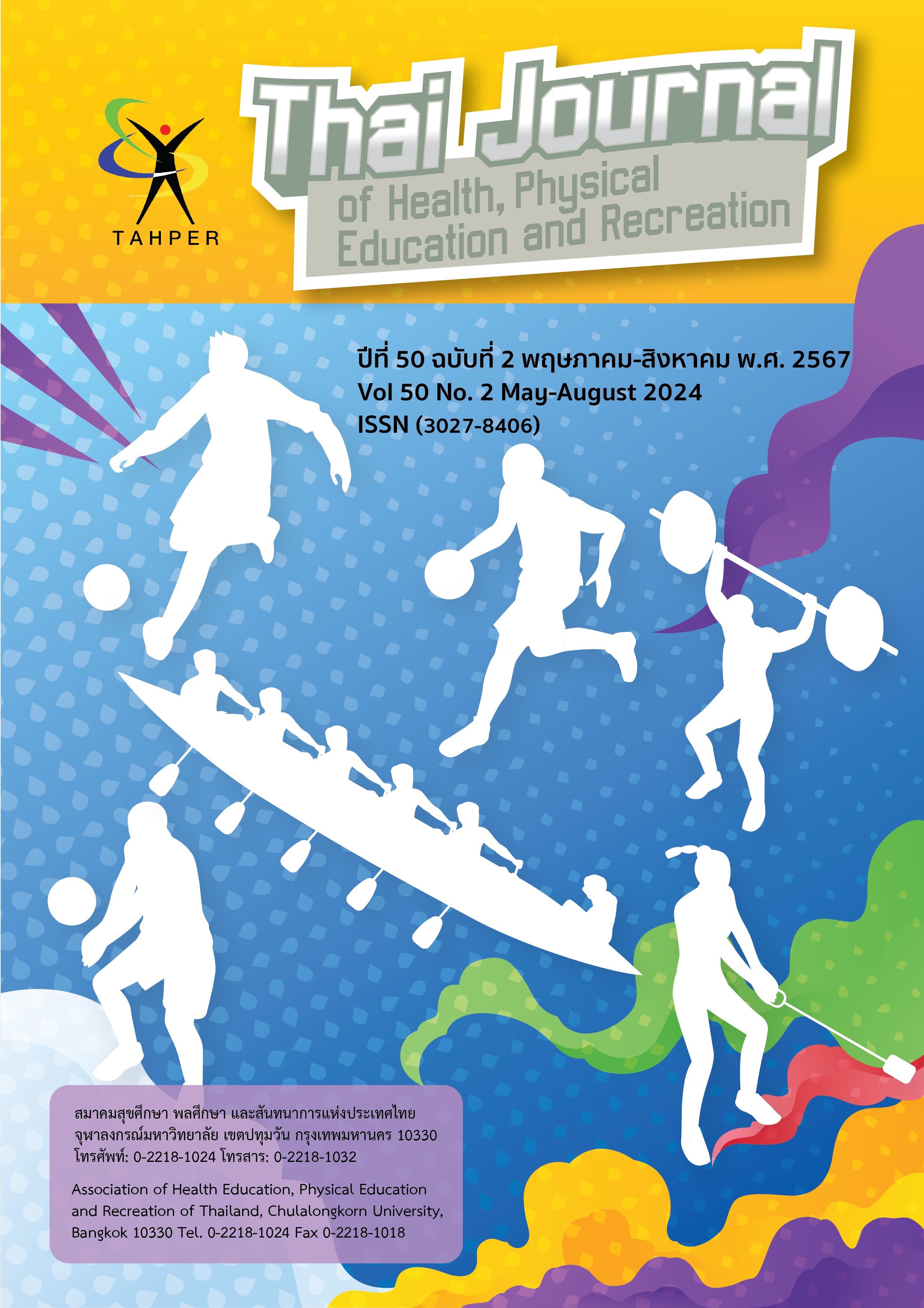The Study of Physical Fitness and Technical Skill Performance according to age level and birth-month distribution in Young Soccer Players
Main Article Content
Abstract
The purpose of this research were to investigate whether physical fitness and technical skill performance according to age level and birth-month distribution in the Thai youth soccer players. 135 male youth soccer players aged 13-18 years old, who were football player at Nakhonnon wittaya 6 school, Bangkok sports Scholl and Nakhonpathom Municipaloty sports Scholl. All subject were divided into 3 age groups (UI4 U16 and U18). All subject were record birth quartile (Q1 Q2 Q3 and Q4) and were assessed physical fitness (SPARQ Boys and Girls Soccer Testing Protocols) and technical skill performance (Nattawut,1991) . Data were analyzed used mean, standard variation and one–way ANOVA with repeated measure. Multiple comparisons were performed using the Tukey method and Spearman rank correlation coefficient. All test used the 0.05 level of significance.
The results showed that physical fitness and technical skill performance variables were significance (P<0.05) difference between UI4, U16 and U18 but no significant difference between Q1, Q2, Q3 and Q4 could be observed in any physical fitness and technical skill performance. Furthermore more the item of physical fitness and technical skill were significantly correlated to aged level of players (Physical fitness r = -0.62–0.75 and technical skill performance r= -0.65– 0.61 respectively) but there were not found correlation with birth-month distribution. It can be concluded that physical fitness and technical skill performance were not affected by birth-month distribution, it could be suggested that the selection player process should be focused on age level and player ability.
Article Details

This work is licensed under a Creative Commons Attribution-NonCommercial-NoDerivatives 4.0 International License.
Critical thinking in journals is the right of the author. The Association of Health Education, Physical Education and Recreation of Thailand is not always required, to create diversity in ideas and creativity.
ความคิด ข้อวิพากษ์ในวารสารเป้นสิทธิของผู้เขียน สมาคมสุขศึกษา พลศึกษา และสันทนาการแห่งประเทศไทยไม่จำเป็นต้องเห็นชอบด้วยเสมอไป เพื่อให้เกิดความหลากหลายในความคิดและความสร้างสรรค์
References
ณัฐวุฒิ ปล้องเจริญ. 2534. การสร้างแบบทดสอบฟุตบอลสำหรับนักเรียนชั้นมัธยมศึกษา (วิทยานิพนธ์ปริญญาโท). กรุงเทพฯ: มหาวิทยาลัยศรีนครินทรวิโรฒ.
ถนอมวงศ์ กฤษเพ็ชรและชัยพัฒน์ หล่อพิพัฒน์ 2560 ผลกระทบของอายุสัมพัทธ์ที่มีต่อนักกีฬา (ตอนที่ 2). วารสารวิทยาศาสตร์การกีฬา. 16(172): 10-12.
Barnsley, R. H., Thompson, A. H., and Barnsley, P. E. (1992). Hockey successand birthdate: the relative age effect, Canadian Journal of Health, Physical Education, Recreation, 51,23–28.
Bompa T. and M Carrera. (2015). Conditioning young athletes. Human kinetic. Champaign, United state.
Fitness & Science Blog. (2016). soccer test. SPARQ Testing for Soccer. Available Source : http:// www.topendsports.com/sport/soccer/soccer-sparq.htm , July 9, 2016
Greg G. (2009). Completed Conditioning for Soccer. Human Kinetic. Champiang, USA.
Hirose N. (2009). Relationships among birth-month distribution, skeletal age and anthropometric characteristics in adolescent elite soccer player. Journal of Sports Science, 27(11),1159-66.
Lovell, R., Towlson, C., Parkin, G., Portas, M., Vaeyens, R., and Cobley, S. (2015). Soccer player characteristics in English lowerleague development programmes: The relationships between relative age, maturation, anthropometry and physical fitness. PloS One, 10(9),1-14.
Malina, R. M. (1994). Physical growth and biological maturation of young athletes. Exercise and Sport Science Review, 22,389-434.
Pedretti A and A. Seabra. 2015. Relative age effect and its relationship with morphological characteristics and performance in young soccer players. A Revista Brasileira de Cineantropometria e Desempenho Humano, 17(3), 367-377.
Rhodri S. Lloyd and Jon L. Oliver. (2019). Strength and Conditioning for Young Athletes: Science and Application. 2nd edition. Routledge.
Ronnie L, Zohar M, and A Michal. (2021). Relative Age Effect in 14- to 18-Year-Old Athletes and Their Initial Approach to This Effect—Has Anything Changed Over the Past 10 Years? Front Sports Act Living, 3,622120.
Salinero J.J., Perez B., Burillo P. and L L Maria L. (2013). Relative age effect in European professional football. Analysis by position. Journal of Human Sport and Exercise, 8(4),966-973.
Sisodiya A. S. and Y. Monica. 2010. Relationship of anthropometric variables to basketball playing ability. Journal of Advances in Developmental Research, 1(2), 191-194.
Vaeyens, R., Philippaerts, R. M., & Malina, R. M. (2005). The relative age effect in soccer: A match-related perspective. Journal of Sports Sciences, 23(7), 747-756.
Wattie, N., Schorer, J., and Baker, J. (2015). The relative age effect in sport: A developmental system. Journal of Sports Medicine, 45: 83–94.
Wilson, G. (1999). The birthdate effect in school sports teams. European Journal of Physical Education, 4(2),139-145.
Williams J. H. (2010). Relative age effect in youth soccer: analysis of the FIFA U17 World Cup competition. Scandinavian Journal of Medicine & Science in Sports, 20(3), 502-508.


